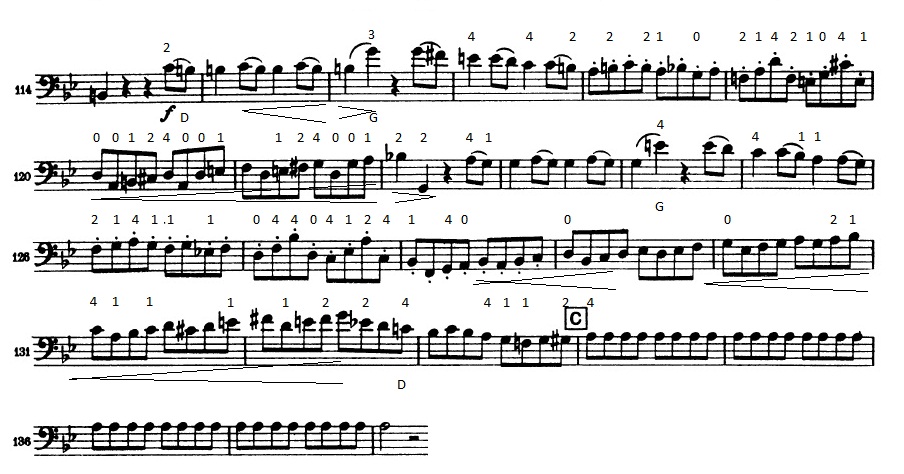mozart 40, first movement no 1

Fig 1 my version
And my You Tube clip is:-
Mozart40_1
Ibase my version on Owen Lee's (see below), with only minor fingering
changes in the bar before C.
The versions in the literature vary much less for this excerpt than for the 4th
movement:-
IMC Orchestral Excerpts (Fred Zimmerman), Vol I, p11-12 - has
the notes, but no clues as to the all important fingerings
Ludwig Streicher, My way of playing the double bass vol 3, p23-24
- almost identical to Owen Lee's version but with a little more reliance on 4
Owen Lee tutorial in The Double Bassist - as with the 4th mov
excerpt, this is a fantastic article. I have not replicated all the
articulations, but the fingerings are:-

Fig 2 Owen Lee version
Lee makes some excellent points in his article, including:-
1 two styles of music - first subject theme (played by the
fiddles at the opening of the movement) which is the anacrusis plus 115-117,
then the anacrusis plus 123-125. This is the tune and should be played thus.
Then there is the accompaniment staccato quaver figure bars 118-121 and 126-137.
2 tempi and rhythm - play at crochet = 100 and keep this tempo
throughout. The performer must resist the temptation for the theme to drag and
the quavers to rush.
3 phrasing - again Lee recommends phrasing to the end of the
lyrical theme passage, which makes sense musically as well as naturally opposing
any tendancy to drag that passage
How to prepare (long term):-
I. work on each style alone. I do the following exercises to
get the feel and style in my head and the bow stroke (on for the theme,
sautille/off-ish for the staccato accompanying figure:-

Fig 3a theme exercise (OK, this has a horrible key change
in the middle, but the point is to this is get the style right). The slurred
quavers should be in time, not rushed or clipped. And the crochets are not too
short, but not too long - Lee marks them dot + line.

Fig 3b staccato figure exercise 1 - play this repeated (as
a round) until mastered, especially the shifts to the D and C#

Fig 3c staccato figure exercise 2 - play this repeated
until mastered. This is harder than 3b, due to the fingerings and string
crossings. I have to think about preparing the LH for the two finger bars (4-4
and 1-1) at a slow tempo and the string crossing is tricky - with the exception
off the first D every other note in the first bar is on a different string, but
then there are two on the A string (C last note of bar 1 and B flat first note
of bar 2). I find myself wanting to fall onto the E string a little early, and
this must be resisted to keep the passage in tempo and not play the bottom F too
soon.
II. play whole passage - after working on the two styles in fig
3, play the whole passage at a slower tempo, to master the transitions between
the two styles. This passage reminds me of a triathlon - its OK doing the swim,
bike and run sections but the transitions between each one are vital. Its
important not to pre-empt the staccato passage by rushing the last two slurred
quavers. I start working on this at around crochet = 84
III. gradually increase tempo up to crochet = 100. Go back to
Fig 3 at your new tempo, when perfected run the whole passage. Only when its
right, move up a metronome marking.
How to prepare (short term, in the audition warm up room) - I
do a shortened version of the Long Term prep. Warm up, get the metronome out and
set to something like crochet = 92, do the exercises fig 3a-3c, run the passage,
fix errors, get it right at your tempo, increase the metronome marking...
What is being tested - just about everything! Rhythm,
flexibility and mobility, articulation, shifting, musicianship
Notes written on the part - I put reminders to myself to read
in the audition just before I play:-
Arrow forward, dont drag (bars 115-117 and 123-125) and hairpin up thro these
bars
Arrow back, dont rush (bars 118-121 and 126-137) and phrase off at the end
Set tempo - think viola quavers at start of the movement
Extension - closed
Tempo - Lee suggests 100
Rhythm - difficult to switch between the two main styles in a
steady tempo
Bow control - tricky to switch from on to off in a controlled
tempo, and vice versa